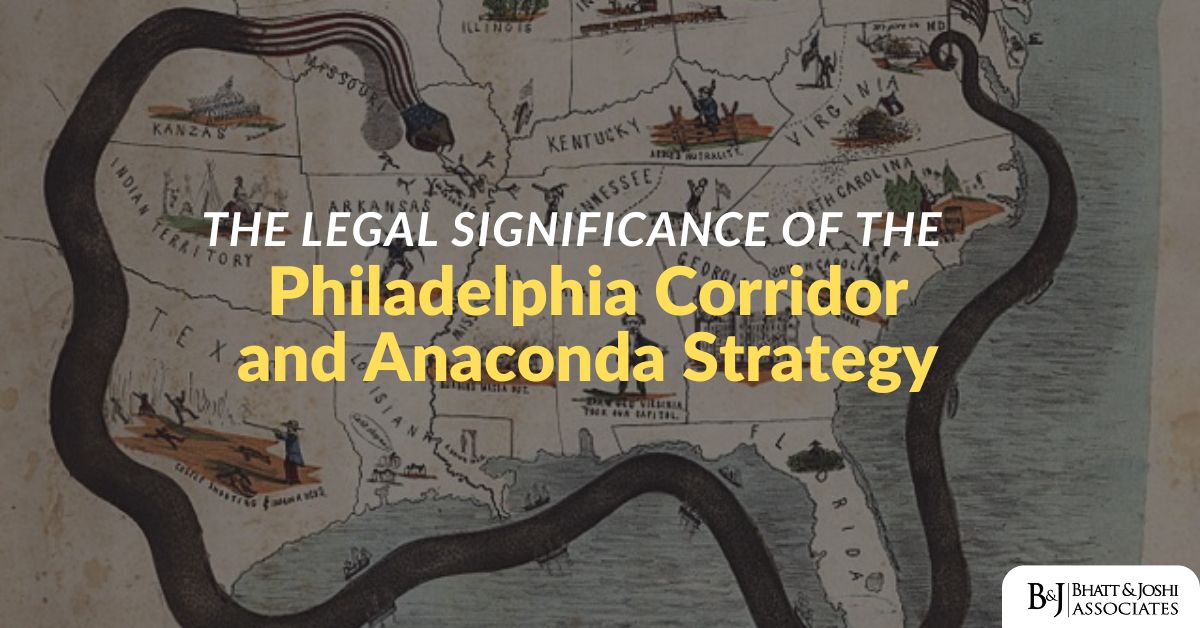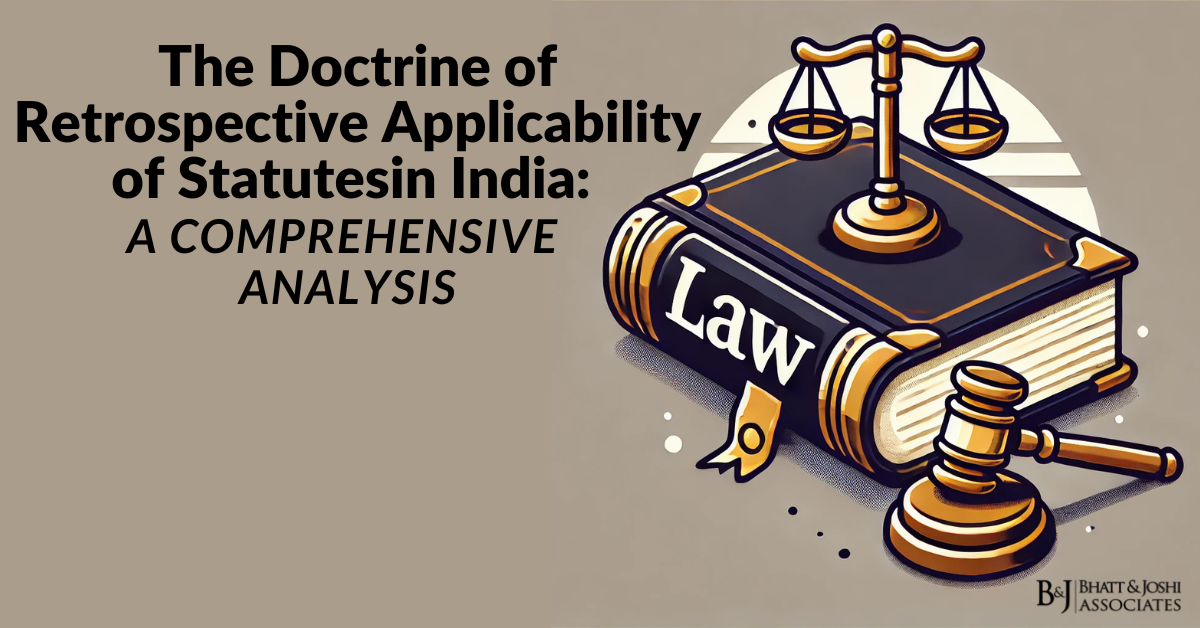Introduction
The Philadelphia Corridor and the Anaconda Strategy, like all military doctrine concepts, have a history rooted in geopolitics and law that serves as the backdrop to the intertwining of military strategy and international legal affairs. Besides providing mechanisms of strategy, these concepts serve as pointers to the legal regimes on warfare, sovereignty, diplomacy, and international relations. Their genesis and development illuminate the international relations power balance and the legal order designed to govern the incessant strife among nations. This article analyzes the legal aspects of terrorism and its encapsulating strategies along with the legal systems’ frameworks and the development of law interpretation done through judicial practice in modern legal systems, to explain as thoroughly as possible what is pertinent and what problems there are.
The Philadelphia Corridor: Overview
The Philadelphia Corridor referred to a region of historical and military significance, which has oftentimes been referred to in global affairs. The corridors generally refer to areas which are important for economic, political, and military activities. While the term is contemporary, it has far-reaching consequences such as strategic areas that nation states or military powers conflict for dominance due to their significance for commerce, communication, and logistical activities. Such corridors are subject to jurisdiction under international laws and agreements, especially if they pass through or affect multiple autonomous nations.
International conflicts have emerged around The Philadelphia Corridor, showcasing its importance to global geography. Dominance over such corridors not only provides access to economically important routes but also serves as a tool for political manoeuvring. Philadelphia Corridor has been claimed to be one of the most strategically important corridors in the world and as such, has been recognized in international laws where treaties and conventions have been made for the use and control of such corridors. The core legal provisions are to prevent uncontrolled excessive use or dominance while taking into account the state’s autonomy in combination with international treaties and stability needs.
Management of Strategic Corridors
International law manages strategic corridors with treaties ratified under the United Nations Convention on the Law of the Sea (UNCLOS) and customary international law. For example, some articles of UNCLOS regulate the transit of vessels through international straits. These principles are put in place to grant access to such corridors for legitimate use while ensuring conflicts that arise from territorial claims are mitigated and state rights are protected.
One of the most well-known cases on the regulation of corridors is the Corfu Channel Case (United Kingdom v. Albania) 1949. This case brought before the International Court of Justice (ICJ) concerned the right of innocent passage through a border strait and the duties of states to provide and guarantee safety in those regions. Albania was found liable for not informing British warships about the mines within her territorial waters and, as a result, damaging her ships. This case laid down the principle of state responsibility within corridors, insisting that states are entitled to have both rights and obligations in these essential regions.
Steps taken towards managing administrative maritime boundaries are not limited to only true corridors. And, just like maritime corridors, overland corridors, particularly those that cross several countries or are important trade arteries, are managed using bilateral and multilateral treaties. These treaties frequently deal with matters involving the right of access, security, and even the ecosystem. For instance, different treaties govern the transport corridors of the Eurasian region that join Europe with Asia to ensure proper and fair access to these important routes.
The Anaconda Strategy: A Historical Perspective
The Anaconda Strategy comes from the American Civil War, where Union Control forces developed a plan to encircle and economically strangle the Confederacy using major waterways and supply line control. The military objective of this strategy was to try and contain the Confederacy by cutting off its supplies and resources and preventing it from sustaining the war. In modern times, however, the concept has expanded and now includes the application of economic, political, and military power to bring an adversary to a position of compliance through weakening. Although originating from military strategy, the Anaconda Strategy concepts have been adopted in international relations and economic policies.
Its use within modern circles truly demonstrates why this strategy remains useful. Recent sanctions and blockades within contemporary geopolitics seem to reflect the Anaconda Strategy and its intent of isolating certain nations or entities. Such moves pose complex legal challenges in international law towards the concepts of sovereignty, non-intervention, and the use of force. The laws concerning such policies do exist, but they are quite vague due to the amount of usually conflicting state goals and international rules.
Legal Implications of the Anaconda Strategy
The Anaconda Strategy is frequently employed as a modern-day analogy to help explain sanctions or other forms of blockades. Such actions are taken to ‘protect’ the international order and peace, yet, there also exist considerable legal and moral issues. Blockades, which are considered part of the Anaconda Strategy, are governed by the San Remo Manual on International Law Applicable to Armed Conflicts at Sea. These laws have instructions on the principles of proportionality and the necessity to limit harm to civilians during conflicts.
Blockades and their legality are some of the most controversial subjects in international law. In the case of Nicaragua v United States (1986), the ICJ dealt with economic measures of isolation regarding the United States. In this ruling, the Court affirmed that there was indeed a law infringement when the US supported rebel Contah actions and when the US undertook the mining of Nicaraguan harbours. It added that these actions violated international law. This decision showed that there should also be compliance, and not merely strategic factors that legislate economic and military action.
Legal Aspects of Geopolitical Dimensions
Both the Philadelphia Corridor and the Anaconda Strategy exemplify the symbiosis of geography and law. Strategic maritime or overland corridors are often the focus of geopolitical rivalry. Likewise, circumvention strategies or those based on economic exclusion often result in legal conflicts regarding the implementation of such strategies or their results.
Customary Law and International Treaties
With the control and use of strategic corridors in mind, as well as the implementation of isolation strategies, treaties such as UNCLOS, the Geneva Conventions, and the Hague Conventions, provide a framework for resolving such conflicts. Article 2(4) of the United Nations Charter, for example, stipulates that force may not be used against the territorial integrity or political independence of any state. This principle is important for actions that involve the blockade of passageways or control over important corridors.
International customs laws are also helpful in these matters. Freedom of navigation, provided by UNCLOS and supported in many cases, guarantees that no one state may dominate essential trade and security routes. A proportionality approach, which is part of international humanitarian law, seeks to mitigate the negative effects and impact of certain actions, such as blockades, on civilians.
Judicial Precedents Shaping Strategy Corridor Laws
Judicial decisions have had a profound impact on the law regarding the Philadelphia Corridor and Anaconda Strategy. Courts and other adjudicating bodies have dealt with issues of territorial sovereignty, the legality of blockades, and states’ rights over important strategic corridors.
One such case is the Trail Smelter Arbitration (United States v. Canada, 1941), which decided that states should control their internal activities in order not to cause damage to outside states. Although this is not directly tied to corridors and strategies, it does illustrate the more general notion of the legal responsibility of a state, which is relevant in conflicts concerning certain conduits or actions taken by a state towards other states.
The 1997 case Concerning the Gabčíkovo-Nagymaros Project is one of the most notable cases in the International Court of Justice’s history, where Hungary and Slovakia presented questions regarding sovereignty, conservation, and resource allocation. While this judgment is based on a dam project, it offers valuable commentary on the extent to which state interests can conflict with international obligations and is useful for understanding conflicts over strategic corridors.
Present Issues and Their Importance
In the modern context, the Philadelphia Corridor and the Anaconda Strategy have developed new meanings. These, along with other strategies, have become more complex as a result of the evolution of technology and change in global politics. The growing focus on cybersecurity is an example of strategic approaches to isolation and poses new challenges concerning the implementation of laws internationally.
Regulatory Problems
Regulating strategic corridors for international travel as well as implementing methods for the isolation of a state is contentious. The proliferation of non-state actors, including big businesses and terrorists, further complicates the observance of legal standards. Moreover, new forms of warfare that blend traditional military action with hacking and propaganda create new legal challenges.
For instance, the 2017 NotPetya cyberattack which is said to involve state archetypes showcased the capability of cyberattacks to inflict chaos in the military infrastructure and the economy. Although not directly connected to the Anaconda Strategy, such scenarios underscore the growing risk of legal enclosures due to circumstantial and strategic encircling and isolation, which require legal control measures.
Conclusion
Like the Philadelphia Corridor, the Anaconda Strategy illustrates the intersection of geography, strategy, and law. Their legal aspects concern the relations between the boundaries of competent authority and usage, the court orders that delimit these boundaries, and the changing realities of contemporary politics. In looking at those issues in the light of international law, we appreciate much more the logic behind the control of strategic corridors and the implementation of encirclement and isolation strategies within the globalized context. These history and law-based narratives advanced aid in comprehending the frameworks that can be utilized in shaping future relations and resolving conflicts internationally.














